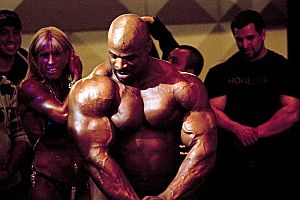One of the most common myths about heavy weight training is that it will make you less flexible. Many of us have an image in our mind of a typical bulked up bodybuilder who can barely manage to turn his head to the left or right. However, if weight training is performed correctly, incorporating a full range of motion, heavy weight training can actually enhance your flexibility. 
This misconception about weight training leading to inflexibility has remained tenaciously in people’s minds, despite the fact that studies as long ago as the 1960s and 1970s proved otherwise. Later studies have confirmed that properly performed strength training exercises serve to increase flexibility rather than reduce it.
A 2002 study published in the Journal of Strength and Conditioning Research evaluated the effect on flexibility of a 10-week resistance training program on a group of 11 elderly female subjects. The control group consisted of eight elderly women who were physically inactive. The women’s level of flexibility was assessed by a sit-and-reach test performed both before and after the 10-week training period. Using resistance machines, the women in the training group performed eight different strength training exercises (seated row, seated biceps curl, seated triceps press, shoulder press, chest press, calf press, abdominal crunch and leg press) without performing any flexibility exercise. The study found that the training group women had achieved an average increase of 13% more flexibility over the control group by the end of the training program.
Another study, published the following year in the same journal, found that flexibility was greater in subjects who used light weights (1-3 pounds) on their wrists and ankles during a 10-week training program than the control group who used no weights while training. They surpassed the control group in five out of ten flexibility measures, including left and right neck rotation, knee flexion, hip extension and ankle dorsiflexion.
To maintain good flexibility while training with weights, learn to vary your workouts so that you do not repeat the same actions over and over. This will encourage your muscles to keep from shortening and becoming less flexible. Weight training exercises should involve the full range of motion in order to build strength while maintaining flexibility.
Experts advise that you perform some stretches after your workout (never before, as it can temporarily weaken your muscles) in order to stretch and lengthen any muscles that may have become shortened during training. The more flexible you are, the more weight you can handle without increasing your risk of injury. Ease gradually into each stretch, being sure not to bounce, which can cause small tears in the muscle that will be replaced by scar tissue, reducing your flexibility.
For Fitness and Flexibility information and exercises contact Doctor Michael Kauf, as a former athlete, I have plenty exercises to show each person no matter their age or athletic ability.
